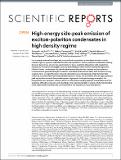High-energy side-peak emission of exciton-polariton condensates in high density regime
Abstract
In a standard semiconductor laser, electrons and holes recombine via stimulated emission to emit coherent light, in a process that is far from thermal equilibrium. Exciton-polariton condensates -- sharing the same basic device structure as a semiconductor laser, consisting of quantum wells coupled to a microcavity -- have been investigated primarily at densities far below the Mott density for signatures of Bose-Einstein condensation. At high densities approaching the Mott density, exciton-polariton condensates are generally thought to revert to a standard semiconductor laser, with the loss of strong coupling. Here, we report the observation of a photoluminescence sideband at high densities that cannot be accounted for by conventional semiconductor lasing. This also differs from an upper-polariton peak by the observation of the excitation power dependence in the peak-energy separation. Our interpretation as a persistent coherent electron-hole-photon coupling captures several features of this sideband, although a complete understanding of the experimental data is lacking. A full understanding of the observations should lead to a development in non-equilibrium many-body physics.
Citation
Horikiri , T , Yamaguchi , M , Kamide , K , Matsuo , Y , Byrnes , T , Ishida , N , Löffler , A , Hoefling , S , Shikano , Y , Ogawa , T , Forchel , A & Yamamoto , Y 2016 , ' High-energy side-peak emission of exciton-polariton condensates in high density regime ' , Scientific Reports , vol. 6 , 25655 . https://doi.org/10.1038/srep25655
Publication
Scientific Reports
Status
Peer reviewed
ISSN
2045-2322Type
Journal article
Collections
Items in the St Andrews Research Repository are protected by copyright, with all rights reserved, unless otherwise indicated.

